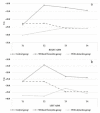Effects of 1 Year of Lifestyle Intervention on Institutionalized Older Adults
- PMID: 34300062
- PMCID: PMC8303470
- DOI: 10.3390/ijerph18147612
Effects of 1 Year of Lifestyle Intervention on Institutionalized Older Adults
Abstract
The socio-economic and health consequences of our ageing population are well documented, with older adults living in long-term care facilities amongst the frailest possessing specific and significant healthcare and social care needs. These needs may be exacerbated through the sedentary behaviour which is prevalent within care home settings. Reducing sedentary time can reduce the risk of many diseases and improve functional health, implying that improvements in health may be gained by simply helping older adults substitute time spent sitting with time spent standing or in light-intensity ambulation. This study identified the impact of 1 year of lifestyle intervention in a group of older adults living in a long-term care setting in Italy. One hundred and eleven older adults (mean age, 82.37 years; SD = 10.55 years) participated in the study. Sixty-nine older adults were in the intervention group (35 without severe cognitive decline and 34 with dementia) and 42 older adults were in the control group. Data on physical functioning, basic activities of daily living (BADL) and mood were collected 4 times, before, during (every four months) and after the 1 year of intervention. The lifestyle intervention focused on improving the amount of time spent every week in active behaviour and physical activity (minimum 150 min of weekly activities). All participants completed the training program and no adverse events, related to the program, occurred. The intervention group showed steady and significant improvements in physical functioning and a stable situation in BADL and mood following the intervention in older adults with and without dementia, whilst the control group exhibited a significant decline over time. These results suggest that engagement in a physical activity intervention may benefit care home residents with and without dementia both physically and mentally, leading to improved social care and a reduced burden on healthcare services.
Keywords: ADL; dementia; depression; mobility; physical activity; physical functioning.
Conflict of interest statement
The authors declare no conflict of interest.
Figures






Similar articles
-
Effectiveness of preventive in-home geriatric assessment in well functioning, community-dwelling older people: secondary analysis of a randomized trial.J Am Geriatr Soc. 1999 Apr;47(4):389-95. doi: 10.1111/j.1532-5415.1999.tb07228.x. J Am Geriatr Soc. 1999. PMID: 10203111 Clinical Trial.
-
Passive exercise to improve quality of life, activities of daily living, care burden and cognitive functioning in institutionalized older adults with dementia - a randomized controlled trial study protocol.BMC Geriatr. 2018 Aug 14;18(1):182. doi: 10.1186/s12877-018-0874-4. BMC Geriatr. 2018. PMID: 30107789 Free PMC article. Clinical Trial.
-
Effectiveness of interventions to improve family-staff relationships in the care of people with dementia in residential aged care: a systematic review protocol.JBI Database System Rev Implement Rep. 2015 Nov;13(11):52-63. doi: 10.11124/jbisrir-2015-2415. JBI Database System Rev Implement Rep. 2015. PMID: 26657464
-
Behavioural modification interventions for medically unexplained symptoms in primary care: systematic reviews and economic evaluation.Health Technol Assess. 2020 Sep;24(46):1-490. doi: 10.3310/hta24460. Health Technol Assess. 2020. PMID: 32975190 Free PMC article.
-
Stand When You Can: development and pilot testing of an intervention to reduce sedentary time in assisted living.BMC Geriatr. 2020 Aug 6;20(1):277. doi: 10.1186/s12877-020-01647-z. BMC Geriatr. 2020. PMID: 32762644 Free PMC article. Review.
Cited by
-
Systematic Review of the Effects of Exercise and Physical Activity on the Gut Microbiome of Older Adults.Nutrients. 2022 Feb 5;14(3):674. doi: 10.3390/nu14030674. Nutrients. 2022. PMID: 35277033 Free PMC article.
-
Are Gyms a Feasible Setting for Exercise Training Interventions in Patients with Cardiovascular Risk Factors? An Italian 10-Years Cross-Sectional Survey Comparison.Int J Environ Res Public Health. 2022 Feb 19;19(4):2407. doi: 10.3390/ijerph19042407. Int J Environ Res Public Health. 2022. PMID: 35206596 Free PMC article.
-
Physical and Motor Fitness Tests for Older Adults Living in Nursing Homes: A Systematic Review.Int J Environ Res Public Health. 2022 Apr 21;19(9):5058. doi: 10.3390/ijerph19095058. Int J Environ Res Public Health. 2022. PMID: 35564453 Free PMC article.
-
The Social Organization of Quality of Life of Older People in Long-Term Care Facilities: An Institutional Ethnography Approach.Glob Qual Nurs Res. 2025 Mar 12;12:23333936251324267. doi: 10.1177/23333936251324267. eCollection 2025 Jan-Dec. Glob Qual Nurs Res. 2025. PMID: 40078597 Free PMC article.
-
It Is Not Just a Matter of Motivation: The Role of Self-Control in Promoting Physical Activity in Older Adults-A Bayesian Mediation Model.Healthcare (Basel). 2024 Aug 20;12(16):1663. doi: 10.3390/healthcare12161663. Healthcare (Basel). 2024. PMID: 39201220 Free PMC article.
References
-
- Ciairano S., Liubicich M.E., Rabaglietti E. The Effects of a Physical Activity Programme on the Psychological Wellbeing of Older People in a Residential Care Facility: An Experimental Study. Ageing Soc. 2010;30:609–626. doi: 10.1017/S0144686X09990614. - DOI
-
- Spasova S., Baeten R., Vanhercke B. Challenges in Long-Term Care in Europe. Eurohealth. 2018;24:7–12.
MeSH terms
LinkOut - more resources
Full Text Sources

